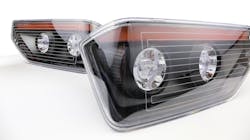Giving LEDs some TLC: Inspection and diagnostic best practices
For the 2021 International Roadcheck, the Commercial Vehicle Safety Alliance tasked its certified inspectors across the U.S., Canada, and Mexico to make lighting out-of-service violations a priority. In the U.S., these CVSA inspectors logged 9,691 out-of-service violations, with lighting (headlamps, tail lamps, stop lamps, turn signals, and lamps on projecting loads) as the third most frequent—following brake systems and tires—accounting for 14.1% of the violations. This is up from 13.5% in 2020. Canada nearly doubled lighting OOS violations from 7.5% in 2020 to 12.4% in 2021, while in Mexico, lighting was the top offender, responsible for 54% of the 72 total violations, up from 22.8% in 2020.
What this all means is that fleets need to take a closer look at their trucks’ lighting, particularly their headlights, so their drivers can safely see the road—and potential dangers—ahead.
See also: Look on the bright side
The vast majority of new vehicles employ LED (Light Emitting Diode) headlamps—95% according to vehicle lighting manufacturer Optronics International—and a major selling point is that LEDs are maintenance-free for life. That said, they still require some tender loving care (TLC).
“LED lighting is pretty much the same as incandescent,” said Kyle O’Dell, director of engineering and new product development at Optronics International, a lighting manufacturer. “They just require less power and are much more efficient, much brighter, and much crisper lighting.”
LED lighting is solid state and does not use filaments, so lamps will not fracture due to the excessive vibrations and stressful conditions common in the CV market, explained Paul Sniegocki, EVP of engineering and CTO at Clarience Technologies, parent company of Truck-Lite.
Truck-Lite developed LED signal lighting and harnessing in the mid-90s, with LED headlights for military vehicles coming in the mid-2000s. “You can imagine how fragile a 24-volt filament is in some of the theaters in which they were operating,” Sniegocki recalled. “And there was this very significant failure rate of these incandescent headlamp systems.”
These robust headlamps then carried over to commercial vehicle applications. Truck-Lite became the first to offer lifetime warranties for its CV lights and harnesses.
But the technological advances within the module don’t make the fragile wires connecting them to the rest of the truck any less vulnerable. And it gets rough under a truck, with rocks, debris, and road salt all coming into contact with the lights’ wires and harnesses.
“Corrosion is the biggest factor when it comes to lights and CSA violations,” explained Dan Miller, field services/special projects manager at Peterson Manufacturing, which makes commercial vehicle and trailer harness and lighting systems. Peterson launched a modular harness system for trailer lighting called the PetersonPATRIOT last year, with a waterproof design specially defending against water and highly corrosive magnesium chloride (a chemical that helps road salt stick).
Along with corrosion, the TMC Recommended Practice 186—Wire and Cable Repair Guides—said that excessive heat, vibration, and routing issues can damage wires, terminal seals, and connector bodies. Whatever the cause, the issue creates plenty of work for maintenance shops.
“Wiring repairs for lighting are honestly one of our most common repairs,” said Lucas Coyle, master technician at TA Truck Service in Gaston, Indiana. “We constantly have corrosion and cut wiring issues.”
For details on how to splice wires, Coyle and TMC offer some tips here. But the first step to addressing these issues is through pre-check inspection by the driver and scheduled visual inspections by maintenance professionals during routine checkups.
See also: Illuminating best practices for effective LED headlight installationInspections
According to Marcus Hester, chief marketing officer at Optronics, basic visual inspections are often overlooked despite their effectiveness. Along with a walkaround to ensure all lights are on and operable, he advises inspecting the harness and connections. This should be done during annual preventive maintenance inspections, and technicians should key in on a few areas, according to O’Dell: “On the harnesses, the main areas you’ll see nicked wires and things like that are where they go through fittings, or through plates that don’t have grommets, aren’t properly insulated, or have convoluted tubing.”
Nicks create a major point of entry for corrosion, so any damaged wires should be cut and replaced or repaired, O’Dell advised.
Neatly organized wiring will make inspections far easier.
“You’ve got to keep the wiring secure and up out of harm’s way,” noted Miller, who railed against “conglomerations of wiring,” the result of hurried fixes. Perhaps this happened during an emergency service call after a tire blew and forced the mudflap into the wiring and damaging it, he theorized.
“You start looking at this rat’s nest of multiple wiring repairs, where people have gone in and repaired things, probably in the heat of battle, and that was not done correctly, which causes all kinds of other issues down the line,” Miller said. He advised that the tech should cut out all the wiring that was improperly repaired in order to remove the bad splicing and eliminate the moisture/corrosion entrance points. This will help fleets avoid lost time and money.
He also said certain test tools can cause unintended problems.
“We need to throw away all the probe test lights, because when you stick the wire, it creates a path for moisture [and] creates a path for corrosion,” Miller asserted. “You might not have a problem today, but you will tomorrow.”
Diagnosing
LED headlights themselves have a significant level of protection built into the circuits and lamp architecture, along with self-diagnostic capabilities done on the lamp driver board, Sniegocki explained. “They’re able to provide and deal with the electronic noise that might occur throughout these systems,” he said. “And they’re able to filter that and provide only the necessary signals back to the diagnostics architecture on the truck itself.”
This protocol includes not only power and ground to the LED headlamp, but the CAN bus or LIN bus protocols depending on the vehicle architecture.
Technicians will always want to make sure one tool is nearby to diagnose headlight issues: a multimeter.
“The multimeter will tell you if you have your voltages correct—not just that you have voltage, but if you have the correct voltage,” Miller said. “When technicians go through the troubleshooting steps with the proprietary software of the manufacturer, it’s going to ask them what the voltage is, because that means something.”
Coyle agreed: “Keep that multimeter in your back pocket, because you’re going to need it.”
The multimeter itself requires a quick check to ensure it is working properly. Coyle advised to do “a quick voltage and resistance test with your leads to make sure your meters work.”
Coyle always trains his technicians to “go back to the basics” and reminds them to always check if the power side has voltage and ground side does not.
“You can cut diagnostics down very quickly with just a couple of quick tests,” said Coyle, who explained how OEMs’ software provides active and inactive fault codes emanating from the headlamp module.
Other systems can become impacted by issues with the headlamp electrical system. “The module can shut that circuit off if there’s a short causing the circuit to be damaged,” Coyle said.
Coyle explained one time he ran into an issue where all the lights, the horn, and steering wheel switches on a Freightliner Cascadia were not working because the clock spring caught fire, melted some wires, and shorted the data link. Once he unplugged the burnt component, everything began to work.
To further speed up lighting troubleshooting, Coyle built his own specialized diagnostics cart.
“I bought a really cheap, really small flat-screen TV and put it on one side and a laptop tray on the other,” he explained. “That way I’ve got my computer set up so I can have wiring diagrams up on one side and fault codes and diagnostics on the other side.”
This helps Coyle better understand if a circuit is out, where it gets power from, and helps him identify if there are any common issues in other circuits.
He found that technicians often do not test wire resistance under a load. For small wires, Coyle uses the Electronic Specialties LOADpro tool.
“The LOADpro uses the truck-supplied power and ground on the circuit to make a connection across the multimeter leads,” he said. “This allows the circuit to be in a loaded state, and you are able to monitor a voltage drop on your multimeter without having to back probe the circuit. This can make voltage tests a lot easier, and you are less likely to damage the seals to the wiring terminals.”
About the Author

John Hitch
Editor-in-chief, Fleet Maintenance
John Hitch is the award-winning editor-in-chief of Fleet Maintenance, where his mission is to provide maintenance leaders and technicians with the the latest information on tools, strategies, and best practices to keep their fleets' commercial vehicles moving.
He is based out of Cleveland, Ohio, and has worked in the B2B journalism space for more than a decade. Hitch was previously senior editor for FleetOwner and before that was technology editor for IndustryWeek and and managing editor of New Equipment Digest.
Hitch graduated from Kent State University and was editor of the student magazine The Burr in 2009.
The former sonar technician served honorably aboard the fast-attack submarine USS Oklahoma City (SSN-723), where he participated in counter-drug ops, an under-ice expedition, and other missions he's not allowed to talk about for several more decades.

